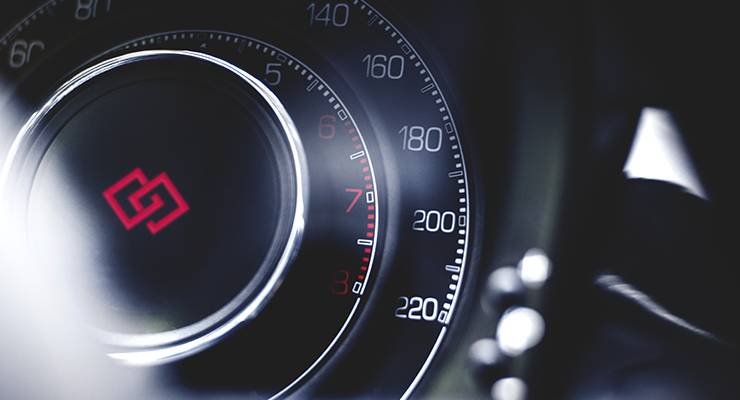Maximum loading speed for your website

When you are on the Internet looking for information, you want it on your screen quickly. Nothing is more annoying than waiting a long time for pages to load and images to appear on them. People expect quite a lot from today’s websites, such as a clear (menu) structure, responsive design and therefore a good loading speed of your website.
Does loading speed affect SEO?
Yes indeed! Search engines such as “Google” or “Bing” have been rating faster websites higher in organic search results for ages. In addition, the speed of a website not only affects search rankings, but has been proven to affect conversion rates, i.e. directly your sales. And who doesn’t want more sales? Research shows that 1 second delay in website load time can cause an average of 7% conversions, 11% fewer page views and 16% decrease in customer satisfaction. A website with €100,000 in sales per day then misses out on €2.5 million in sales on an annual basis.
How fast should pages on your website load?
Research* shows that about 50% of people expect a Web page to load faster than 2 seconds. And 40% of people leave a Web page that takes longer than 3 seconds to fully load.
*Source:
blog.kissmetrics.com
Thus, a maximum load time of 3 seconds is advisable to comply with the above. There are also several myths about better loading speed. Here’s a bright article from 2015 that is still relevant at
Frankwatching
.
So how do you make sure your website loads quickly?
Make sure your website is well built.
Through the use of CMS systems such as
WordPress
,
Joomla!
and
Drupal
building a website or webshop is possible for just about anyone. Of course, there are some snags in deploying these systems. For example, these packages sometimes unnecessarily load ‘Javascript’ and CSS files in or requests to databases for information. Your webmaster can figure this out for you and they can also make sure unused plugins are turned off or preferably removed. Before you start building a website, find out which themes load quickly and are suitable for your site setup. Then check which plugins are still needed to accomplish all your requirements. Look at how many users have already installed these themes and plugins and what kind of reviews they have received. Being up-to-date with your CMS also affects the performance of your website. Nowadays, you can also order hosting with automatic installation of WordPress, Joomla, Magento or another CMS. Often, the CMS is also updated automatically, so you no longer have to worry about this. Earlier, we wrote a blog about choosing a CMS: Which CMS should I choose for my website?
Compress/optimize JavaScript, Stylesheets and HTML files
Slightly more technical, but definitely worthwhile, is compressing JavaScript, stylesheets and HTML files that your Web site uses. In practice, this means that unnecessary spaces, comment lines, whitespace and tabs are removed from the code. This will make your file smaller and load faster. You can rid your stylesheet files of unnecessary characters at
cssminifier.com
. Javascript files can be resized at
javascript-minifier.com
.
Compress the images
In addition, it is very important not to make the images used larger than necessary. Ask your webmaster how many pixels wide and high your images should be for header, blog or photo album and whether it is wise to submit this as .jpg, .gif or .png. We wrote a blog about this earlier:
Images and search engine optimization
. You can also choose to create separate designs for desktop and mobile display, so that a smartphone has even less content to load due to the smaller screen.
Immerse yourself in the hosting party
Third, make sure your website is running at a hosting party where speed is also guaranteed. Such as using fast servers with maximum security, cooling systems and multiple power supplies. With proper security and power, you have the assurance that the servers will continue to perform at their maximum capacity and thus your site will be approachable. Well-cooled servers can guarantee fast data transfer, allowing your site to load better. For example, some data centers work with SSD storage (which requires much less cooling) or work with helium-cooled drives for maximum performance. Cheaper
shared hosting
from good providers works fine for smaller websites. And very large websites obviously use a high-end solution. So it is advisable to check with your hosting party about the data centers used. Information about the servers used at
SQR.NL
can be found here
.
End-user network
The visitor’s Internet speed is itself important. If this user is on a slow network, using an outdated browser or working with a slow router, that also affects the loading speed of your site. First aid for slow reception is then: resetting the router, rebooting the computer, updating the browser, checking firewalls and virus scanners, using proper cabling and checking the wireless router. You can find several scans on the Internet for your Internet speed. We’ve listed a few in a separate article:
Test the speed of your website
.
Conclusion
By improving the load time of your website, you work on search engine optimization and it benefits the user experience. Have you tested how fast your website loads? With our tips to build and check your site correctly, optimize content and house it with the right hosting company, you can get the most out of your online performance. This is how we make you with
SQR.NL
another bit more successful.
